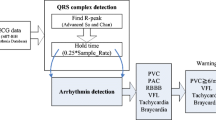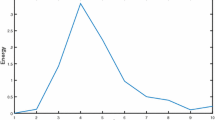Abstract
The automatic analysis of the electrocardiogram (ECG) begins, traditionally, with the detection of QRS complexes. Afterwards, useful information can be extracted from it, ranging from the estimation of the instantaneous heart rate to nonlinear heart rate variability analysis. A plethora of works have been published on this topic; consequently, there exist many QRS complex detectors with high-performance values. However, just a few detectors have been conceived that profit from the information contained in several ECG leads to provide a robust QRS complex detection. In this work, we explore the fusion of multi-channel ECG recordings QRS detections as a means to improve the detection performance. This paper presents a decentralized multi-channel QRS complex fusion scheme that optimally combines single-channel detections to produce a single detection signal. Using six different widely used QRS complex detectors on the MIT-BIH Arrhythmia and INCART databases, a reduction in false and missed detections was achieved with the proposed approach compared with the single-channel counterpart. Furthermore, our detection results are comparable with the performance of other multi-channel detectors found in the literature, showing, in turn, various advantages in scalability, adaptability, and simplicity in the system’s implementation

N QRS complex detectors simultaneously monitor N ECG channels. Once a detection occurs in a given channel, a 150 ms long window is opened to look for detections in other channels. Within this window, yn = + 1 if a QRS complex is detected and yn = − 1 otherwise. A coefficient α n, obtained during a training period and related to the detection performance in channel n, multiplies the detection signal yn, so that greater weights are assigned to ECG channels where single-channel detectors performed better. Finally, the binary detection decision (f ) is obtained from the comparison of the weighted sum of single-channel detections (z) with a fixed threshold (β)
.

Similar content being viewed by others
References
Almeida R, Martínez JP, Rocha AP, Laguna P (2009) Multilead ECG delineation using spatially projected leads from wavelet transform loops. IEEE Trans Biomed Eng 56(8):1996–2005
American National Standard: ANSI/AAMI EC38:1998, Ambulatory Electrocardiographs (1998)
American National Standard: ANSI/AAMI EC57:1998, Testing and Reporting Performance Results of Cardiac Rhythm and ST Segment Measurement Algorithms (1998)
Arbateni K, Bennia A (2014) Sigmoidal radial basis function ANN for QRS complex detection. Neurocomputing 145:438–450
Benitez DS, Gaydecki PA, Zaidi A, Fitzpatrick AP (2000) A new QRS detection algorithm based on the Hilbert transform. In: Computers in cardiology 2000, pp 379–382
Chair Z, Varshney P.K. (1986) Optimal data fusion in multiple sensor detection systems. IEEE Trans Aerosp Electron Syst AES-22(1):98–101
Chouhan V, Mehta S (2008) Detection of QRS complexes in 12-lead ECG using adaptive quantized threshold. Int J Comp Sci Net Sec 8(1):155–163
Christov II (2004) Real time electrocardiogram QRS detection using combined adaptive threshold. Biomed Eng Online 3(1):28
Elgendi M, Björn E, Socrates D, Derek A (2014) Revisiting QRS detection methodologies for portable, wearable, Battery-Operated, and wireless ECG systems. PLOS ONE 9(1):1–18
Ghaffari A, Homaeinezhad M, Akraminia M, Atarod M, Daevaeiha M (2009) A robust wavelet-based multi-lead electrocardiogram delineation algorithm. Med Eng Phys 31(10): 1219–1227
Goldberger AL, Amaral LAN, Glass L, Hausdorff JM, Ivanov PC, Mark RG, Mietus JE, Moody GB, Peng CK, Stanley HE (2000) PhysioBank, PhysioToolkit, and PhysioNet: components of a new research resource for complex physiologic signals. Circulation 101(23):e215–e220
He R, Wang K, Li Q, Yuan Y, Zhao N, Liu Y, Zhang H (2017) A novel method for the detection of R-peaks in ECG based on K-nearest neighbors and particle swarm optimization. EURASIP J Adv Signal Process 2017:82
Huang B, Wang Y (2009) Detecting QRS complexes of two-channel ECG signals by using combined wavelet entropy. In: 2009 3Rd international conference on bioinformatics and biomedical engineering, pp 1–4
Huang B, Wang Y (2009) QRS complexes detection by using the principal component analysis and the combined wavelet entropy for 12-lead electrocardiogram signals. In: 2009 Ninth IEEE international conference on computer and information technology, vol 1, pp 246–251
Jain S, Ahirwal M, Kumar A, Bajaj V, Singh G (2017) QRS detection using adaptive filters: a comparative study. ISA Trans 66:362–375
Laguna P, Jané R., Caminal P (1994) Automatic detection of wave boundaries in multilead ECG signals: validation with the CSE database. Comput Biomed Res 27(1):45–60
Ledezma CA, Perpinan G, Severeyn E, Altuve M (2015) Data fusion for QRS complex detection in multi-lead electrocardiogram recordings. In: 11th international symposium on medical information processing and analysis, vol 9681. International Society for Optics and Photonics, p 968118
Mehta S, Lingayat N (2008) Combined entropy based method for detection of QRS complexes in 12-lead electrocardiogram using SVM. Comput Biol Med 38(1):138–145
Mehta S, Lingayat N (2009) Application of support vector machine for the detection of P- and T-waves in 12-lead electrocardiogram. Comput Methods Prog Biomed 93(1):46–60
Mehta S, Lingayat N (2009) Identification of QRS complexes in 12-lead electrocardiogram. Expert Syst Appl 36(1):820–828
Meyer C, Gavela JF, Harris M (2006) Combining algorithms in automatic detection of QRS complexes in ECG signals. IEEE Trans Inf Technol Biomed 10(3):468–475
Mondelo V, Lado MJ, Méndez AJ, Vila XA, Rodríguez-linares L (2017) Combining 12-lead ECG information for a beat detection algorithm. J Adv Theoret Appl Inform 3(1):5–9
Moody GB, Mark RG (2001) The impact of the MIT-BIH arrhythmia database. IEEE Eng Med Biol Mag 20(3):45–50
Moraes JCTB, Freitas MM, Vilani FN, Costa EV (2002) A QRS complex detection algorithm using electrocardiogram leads. In: Computers in cardiology, pp 205–208
Nayak C, Saha SK, Kar R, Mandal D (2019) An optimally designed digital differentiator based preprocessor for R-peak detection in electrocardiogram signal. Biomed Signal Process Control 49:440–464
Okada M (1979) A digital filter for the ORS complex detection. IEEE Trans Biomed Eng BME-26(12):700–703
Pahlm O, Sörnmo L (1984) Software QRS detection in ambulatory monitoring – a review. Med Biol Eng Comput 22(4):289–297
Pan J, Tompkins WJ (1985) A real-time QRS detection algorithm. IEEE Trans Biomed Eng BME-32 (3):230–236
Ramakrishnan AG, Prathosh P, Ananthapadmanabha TV (2014) Threshold-Independent QRS detection using the dynamic plosion index. IEEE Signal Process Lett 21(5):554–558
Rincón F, Recas J, Khaled N, Atienza D (2011) Development and evaluation of multilead wavelet-based ECG delineation algorithms for embedded wireless sensor nodes. IEEE Trans Inf Technol Biomed 15(6):854–863
Silva I, Moody B, Behar J, Johnson A, Oster J, Clifford G D, Moody GB (2015) Robust detection of heart beats in multimodal data. Physiol Meas 36(8):1629
Silva I, Moody GB (2014) An open-source toolbox for analysing and processing physionet databases in MATLAB and octave. J Open Res Soft 2(1):e27
Thakor NV, Webster JG, Tompkins WJ (1983) Optimal QRS detector. Med Biol Eng Comput 21 (3):343–350
Torbey S, Akl SG, Redfearn DP (2012) Multi-lead QRS detection using window pairs. In: 2012 annual international conference of the IEEE engineering in medicine and biology society, pp 3143–3146
Willems JL, Arnaud P, Bemmel JHV, Bourdillon PJ, Degani R, Denis B, Graham I, Harms F M, Macfarlane PW, Mazzocca G, Meyer J, Zywietz C (1987) A reference data base for multilead electrocardiographic computer measurement programs. J Am Coll Cardiol 10(6):1313–1321
Xiang Y, Lin Z, Meng J (2018) Automatic QRS complex detection using two-level convolutional neural network. BioMedical Engineering OnLine 17(1):13
Yochum M, Renaud C, Jacquir S (2016) Automatic detection of p, QRS and T patterns in 12 leads ECG signal based on CWT. Biomed Signal Process Control 25:46–52
Author information
Authors and Affiliations
Corresponding author
Additional information
Publisher’s note
Springer Nature remains neutral with regard to jurisdictional claims in published maps and institutional affiliations.
Electronic supplementary material
Below is the link to the electronic supplementary material.
Rights and permissions
About this article
Cite this article
Ledezma, C.A., Altuve, M. Optimal data fusion for the improvement of QRS complex detection in multi-channel ECG recordings. Med Biol Eng Comput 57, 1673–1681 (2019). https://doi.org/10.1007/s11517-019-01990-3
Received:
Accepted:
Published:
Issue Date:
DOI: https://doi.org/10.1007/s11517-019-01990-3




